New homeowners need to be familiar with their home’s plumbing system to prevent and tackle any future problems. This includes knowing where your main and individual water shutoff valves are, and understanding how to read your water meter. Regular maintenance is also vital; from inspecting for pipe insulation to prevent freezing, practicing simple drain cleaning methods, and having a basic plumbing toolkit handy. After all, being armed with the right knowledge makes a big difference when it comes to keeping your home safe and dry. Now, let’s get started on understanding the basics.
One crucial tip for new homeowners is to schedule a professional plumbing inspection before moving in to identify any underlying issues. Additionally, it’s important to locate the main water shutoff valve in case of emergencies and familiarize yourself with individual shutoff valves for fixtures and appliances.
Plumbing Basics for New Homeowners
Alright, so you’ve got the keys to your new place in Santa Cruz, and as you settle in, it’s time to familiarize yourself with the Santa Cruz plumbing basics. First and foremost, locating the main water shutoff valve should be a top priority. This valve is like the control center for your home’s water supply. In case of a plumbing emergency, such as a burst pipe, you’ll need to know where this valve is located and how to shut off the water supply.
The main shutoff valve is typically located near the front of the house, in the garage, or near the water heater. Take a moment to locate it now; don’t wait until an emergency forces you to find it in a panic! If you’re having trouble finding it, consider asking a plumber for help. Knowing the location of this valve can save you from potential water damage and costly repairs in the event of a plumbing mishap.
In addition to the main shutoff valve, it’s equally important to understand individual shutoff valves for fixtures and appliances in your home. These valves allow you to turn off the water supply to specific areas or devices without disrupting the rest of the house.
For instance:
- Your sink likely has a shutoff valve underneath.
- Your toilet also has its own shutoff valve.
- Your dishwasher, washing machine, and other water-connected appliances each have their own shutoff valves.
Tip from top Santa Cruz plumbers – Having the ability to turn off water to these individual areas can be incredibly helpful when making repairs or mitigating damage during an emergency situation.
Consider this scenario: You notice a leak under your bathroom sink. Instead of shutting off water to the entire house, you can simply turn off the valve under the sink and contain the issue until it’s fixed. This not only saves time but also minimizes potential water damage.
Now that we’ve covered these key aspects of plumbing basics, let’s move on to another critical facet—reading the water meter to detect leaks or excessive water usage. Understanding this process can help you identify issues early before they escalate into bigger problems.
Routine Maintenance Tasks
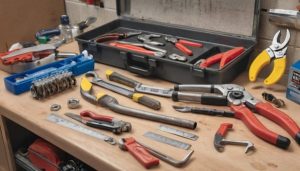
Owning a house comes with its own set of responsibilities, and one of them is keeping your plumbing system well-maintained. Here are some essential routine maintenance tasks that every new homeowner should be aware of and practice regularly to prevent issues down the line.
Inspecting Pipe Insulation
When the temperature drops, uninsulated pipes can freeze and potentially burst, causing a messy and costly problem. Inspect your pipes for proper insulation, especially those located in unheated areas such as the attic, crawl spaces, or garage. Adding insulation to exposed pipes can prevent them from freezing and bursting during cold weather, saving you from a significant headache and expense.
Drain Maintenance
Regular drain maintenance is crucial for preventing clogs and blockages that can lead to slow draining or even backups. A simple yet effective method is to pour hot water down every drain once a month. This helps dissolve any buildup of soap scum, grease, or other substances that can accumulate and cause blockages within the pipes. Additionally, installing mesh drain covers can help prevent debris from entering and clogging the drains.
Basic Plumbing Emergency Kit
It’s always best to be prepared for unexpected plumbing issues, which is why every homeowner should have a basic plumbing emergency kit on hand. This kit should include essential tools such as plungers, drain snakes, adjustable wrenches, utility buckets, plumber’s tape, and duct tape. Being equipped with these tools allows you to address minor plumbing problems promptly and mitigate damage during emergencies.
By integrating these routine maintenance tasks into your homeownership responsibilities, you can prevent common plumbing issues and ensure the longevity and efficiency of your plumbing system. It’s all about staying proactive and attentive to potential areas of concern within your home’s plumbing infrastructure.
Maintenance might not be the most thrilling part of owning a home, but it’s essential for keeping everything running smoothly with minimal disruptions.
Hot Water Tank Care
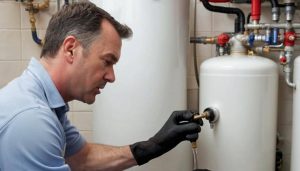
Your hot water tank quietly does a lot of hard work, ensuring you have warm showers and clean dishes. However, it also requires attention to keep working at its best.
Regular Maintenance
Let’s start with one of the most important tasks – draining your hot water tank. Over time, sediment tends to accumulate at the bottom of the tank, which can make your water heater work harder and use more energy. By flushing out a few gallons of water annually, you’re aiding in eliminating that sediment. This will improve your hot water tank’s efficiency and lifespan.
Testing the Pressure Relief Valve
It’s crucial to ensure that the pressure relief valve is operating correctly. This valve prevents excessive pressure from building up inside the tank, which could lead to an explosion if not released. Regularly testing this valve ensures it opens properly when needed. For instance, you can test this by lifting the valve’s tab so a little water is released. If it doesn’t shut off or continues to leak after closing, it may need replacing.
Temperature Settings
Now, let’s talk about temperature. To optimize energy efficiency while ensuring a sufficient supply of hot water, it’s recommended to set the thermostat on your hot water tank to 120°F (49°C). This temperature prevents harmful bacteria growth in the tank while also averting scalding water temperatures.
By regularly performing these simple tasks, you’ll be able to ensure that your hot water tank operates efficiently and lasts longer. Taking care of these maintenance tasks will save you money on energy bills and prevent unexpected malfunctions down the line.
Paying heed to regular maintenance for your hot water tank sets the stage for seamless operation and durability. Now, let’s move on to explore proper fixture and appliance installation.
Proper Fixture and Appliance Installation
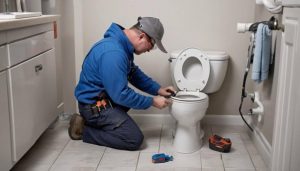
When you move into a new home, you’re excited about setting everything up just right, from the furniture to the fixtures. Plumbing fixtures and appliances are crucial elements for your daily convenience. But if they’re not installed properly, it can lead to a host of issues. To avoid any unwanted surprises and ensure smooth operation, it’s crucial to pay close attention to the installation process.
First and foremost, sealing is key when installing fixtures like sinks, bathtubs, and showers. Ensuring that every connection is properly sealed prevents leaks that can lead to water damage in your home. Securing these connections with the right materials ensures long-lasting reliability and peace of mind.
In addition, when installing appliances such as dishwashers or washing machines, following the manufacturer’s instructions is paramount. Manufacturers provide specific guidelines for installation to ensure proper functionality and safety. Deviating from these instructions could not only lead to performance issues but also void the warranty, leaving you responsible for any repairs or replacements.
For instance, imagine coming home after a long day at work only to find out that your new dishwasher has leaked all over your kitchen floor because it was installed incorrectly. Not only would this cause significant damage to your home, but it would also result in additional expenses for repairs.
Lastly, while many homeowners are adept at simple installations like changing faucets or showerheads, more complex tasks such as installing a new toilet or water heater may require professional assistance. In such cases, opting for professional installation can provide peace of mind knowing that the job is done right by experienced hands.
By understanding the importance of proper sealing, adherence to manufacturer instructions, and considering professional help for complex installations, new homeowners can ensure a reliable and trouble-free plumbing system in their new homes.
As we shift our focus from fixture installations, let’s now explore essential tips for keeping your basement dry and free from water damage.
Basement Waterproofing Tips
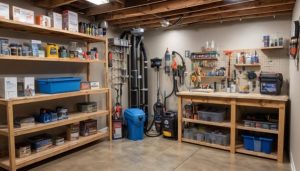
When it comes to homeownership, overlooking the basement’s waterproofing can result in significant headaches down the line. It’s crucial to inspect the foundation for cracks. Small fissures may seem insignificant at first, but they have the potential to let moisture seep into your basement, leading to mold growth and structural damage over time.
Sealing these cracks using hydraulic cement or polyurethane caulk can prevent water from infiltrating your basement. It’s like patching a hole in a boat; if you ignore it, water will keep leaking in until your entire space is affected.
Furthermore, ensure that the grading around your home slopes away from the foundation. This small but essential step helps direct rainwater and snowmelt away from your home instead of letting it accumulate around the foundation, reducing the risk of water seepage into your basement.
Consider this real-life example: a homeowner neglected proper grading around their home. After heavy rainfall, water began seeping into their basement, causing extensive damage to their belongings and leading to costly repairs. A simple adjustment in grading could have spared them from this ordeal.
In addition to addressing surface issues, consider installing a sump pump in your basement. This device actively removes any excess water that accumulates around your foundation, preventing flooding during heavy rains or plumbing mishaps. It acts as a proactive safeguard against water damage.
For instance, a homeowner without a sump pump in their basement experienced a power outage during a storm. Without a backup power source for their existing pump, their basement flooded, resulting in extensive damage to their property and necessitating expensive cleanup operations.
By implementing these waterproofing tips and investing in preventative measures, new homeowners can protect their investment and ensure that their basement remains dry and free from potential water damage.
With basement waterproofing strategies clearly outlined, let’s now turn our attention to preparing for emergencies with an exploration of shut-off valves and leakage mitigation.
Emergency Preparedness: Shut-off Valves and Leaks
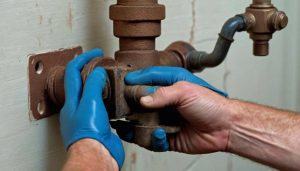
As a new homeowner, it’s crucial to be prepared for unexpected plumbing emergencies that may arise. The main water shutoff valve acts as a superhero for your home’s plumbing system in times of crisis, serving as the first line of defense when a pipe suddenly bursts or a faucet won’t stop leaking.
The main water shutoff valve controls all the water flowing into your home. Knowing its location is paramount and typically, you’ll find it near the front of the house, in the garage, or near the water heater. If you’re uncertain about its location, don’t hesitate to ask or hire a plumber to show you.
Individual Fixture and Appliance Shutoff Valves
Familiarizing yourself with individual shutoff valves for each fixture and appliance in your home is beneficial. These valves allow you to isolate the water supply to specific areas, making it possible to address issues without disrupting the entire water system. Sinks, toilets, and appliances like washing machines and dishwashers usually have their own shutoff valves that can be used during maintenance or emergencies.
It’s also important to recognize signs of a plumbing leak. Detecting leaks early can prevent extensive damage and costly repairs down the road. Signs such as dripping or bubbling sounds, high water bills, changing water meter readings, standing water or mold growth under sinks, wobbly toilets, and water stains on ceilings and walls should not be overlooked.
Water leak detectors can provide an added layer of protection by alerting you to potential leaks before they lead to significant damage. These devices can be strategically placed in key areas prone to plumbing issues such as basements, kitchens, bathrooms, and around water-based appliances.
Remember that a proactive approach to understanding your home’s plumbing system and preparing for emergencies will ultimately save you time, money, and stress in the long run.
Stay vigilant – acquaint yourself with the location of the main water shutoff valve, individual fixture and appliance shut-off valves, and keep an eye out for any signs of a plumbing leak. It’s all about being prepared for anything that might come your way as a homeowner.
Understanding crucial emergency aspects is pivotal for any homeowner. Now let’s move on to delve into general plumbing advice that every new homeowner should know.
General Plumbing Advice for New Homeowners

As a new homeowner, it’s crucial to be proactive about preventing plumbing issues rather than simply reacting to them when they occur. First things first, take stock of your plumbing fixtures and appliances. Watch out for any signs of leaks, dripping or bubbling sounds, high water bills, changing water meter readings, standing water, mold growth, or water stains. Early detection can save you from expensive repairs down the line.
In addition to this, it’s essential to avoid using chemical drain openers as they can harm your pipes. Instead, install mesh drain covers to prevent clogs and make sure to prioritize scheduling professional plumbing inspections. These inspections can reveal any underlying issues with supply lines, fixtures, appliances, and drains before they become major problems.
The last thing any homeowner wants is to deal with water damage or a plumbing emergency. By staying vigilant and addressing issues as soon as they arise, you can spare yourself from potential headaches in the future.
Keep a reliable plumber’s contact information on hand in case you need their services. It’s always better to have it and not need it than to need it and not have it.
Keeping these general plumbing tips in mind as a new homeowner can lead to significant cost savings and peace of mind. It pays off to stay proactive!

Recent Comments